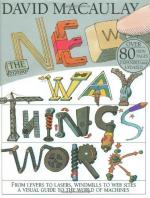
|
| Name: _________________________ | Period: ___________________ |
This quiz consists of 5 multiple choice and 5 short answer questions through Part 2, Harnassing the Elements, Exploiting Heat, Nuclear Power, pp. 142-173.
Multiple Choice Questions
1. Why does a thermos lose heat?
(a) The heat can travel through the stopper.
(b) The molecules eventually slow down.
(c) The argon absorbs the heat.
(d) The oxygen absorbs the heat.
2. What is suction referred to in the act of flying?
(a) Lift.
(b) Floating.
(c) Sinking.
(d) Glide.
3. What are two things that can happen to light rays?
(a) They can be dissipated.
(b) They can be destroyed by gamma rays.
(c) They can be dissolved.
(d) They can be reflected or absorbed.
4. Upon how many major principles do propellers and rudders work?
(a) Three.
(b) Two.
(c) One.
(d) Four.
5. What additional tasks can a boat with two triangular sails do?
(a) Achieve two additional suction forces.
(b) Divide the suction force.
(c) Multiply the suction force by three.
(d) Achieve one additional suction force.
Short Answer Questions
1. What is a first-class lever?
2. What is the term for the process of molecules moving further apart in convection?
3. What is the principle that states energy is neither created nor destroyed?
4. What does the picture of a mammoth pulling a merry-go-round illustrate?
5. Upon what does the amount of upthrust of an object in water depend?
|
This section contains 285 words (approx. 1 page at 300 words per page) |

|




